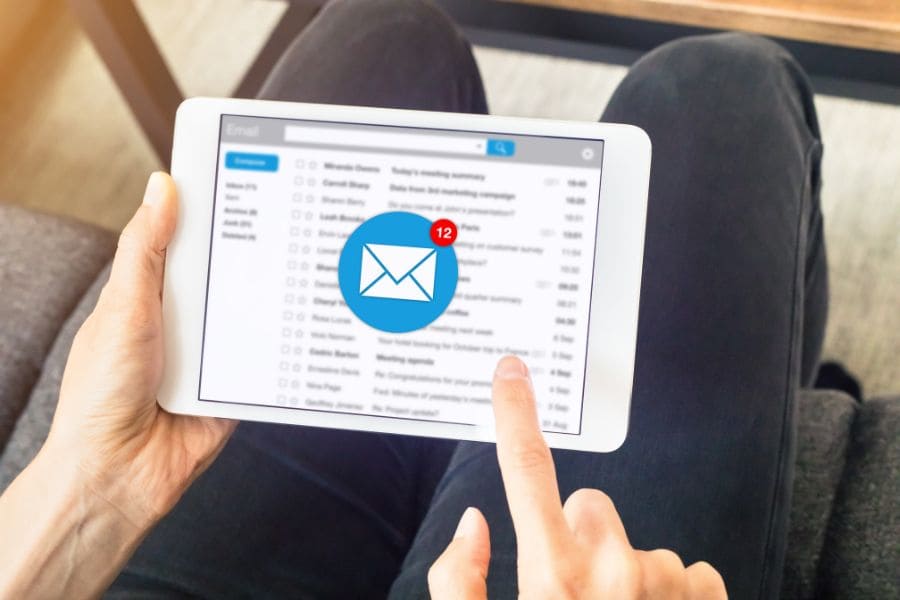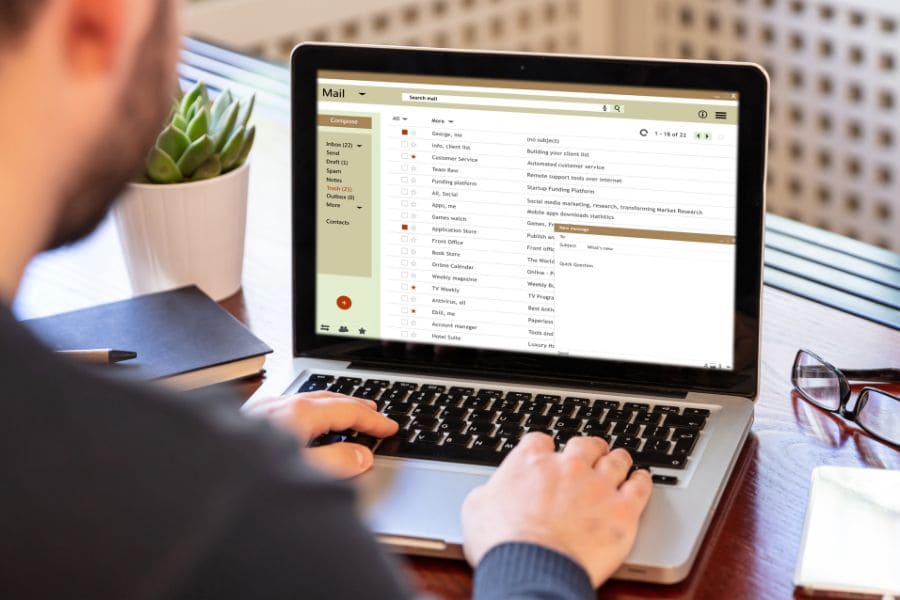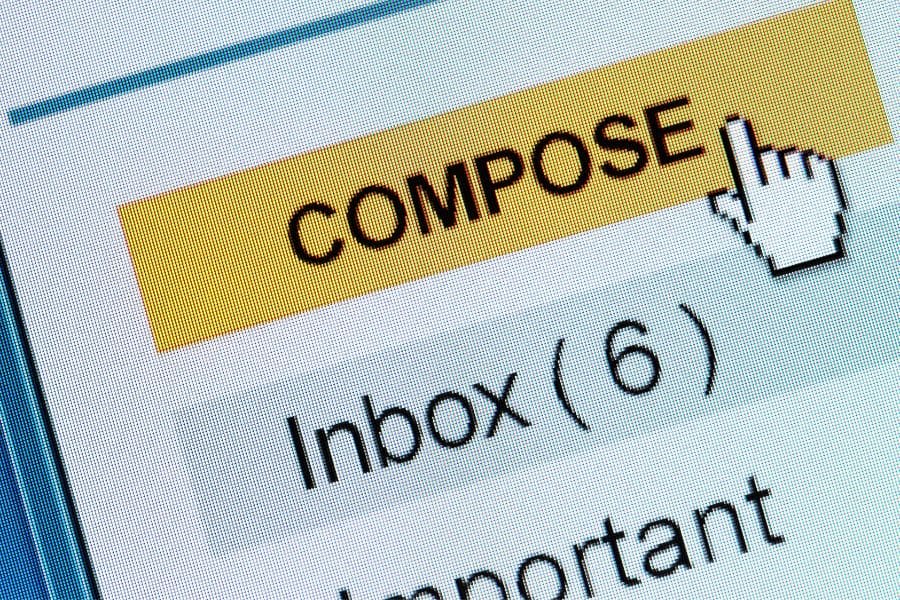Navigating the digital realm of communication, especially when it comes to professional email etiquette, can be a tightrope walk.
One minute, you’re basking in the sweet satisfaction of hitting ‘send’ on an email. The next? The gut-clenching doubt seizes you.
Did I sound too casual? Too stiff? Heaven forbid, was the attachment missing?
An astounding 35% of emails go unread! The unwritten, subtle rules of email etiquette can be a digital jungle, to say the least. But chin up!
You’re just a few moments away from becoming a formal email whiz. From crafting an irresistible subject line to nailing the perfect sign-off, we’re going to arm you with simple, actionable techniques that ensure your emails paint you in the best light.
Ready to bid adieu to those face-palm email moments?

What, Exactly, Is Email Etiquette?
Think of professional email etiquette as the digital equivalent of a neatly tied bow on a beautifully wrapped gift.
At its core, proper email etiquette is about communicating professionally, clearly, and respectfully via email. It’s a guidebook that dictates how we compose, reply, and manage our emails.
But it’s not a one-size-fits-all rulebook.
Like any form of etiquette, it’s designed to adapt to changing times and evolving email communication styles.
Yet, its essence remains unchanged: respect for the receiver’s time and effort.
The importance of email etiquette extends far beyond the “inbox” realm. It’s your digital calling card, your online handshake if you will. It conveys your professionalism, attention to detail, and yes, even your personality to an extent.
We’ve all experienced the delight of reading a well-crafted email and the frustration of grappling with a confusing one. So you intuitively understand how proper email etiquette has the potential to shape perceptions and leave lasting impressions.
Now, you might think: “So what if my email isn’t perfect? It gets the job done!”
True, the world won’t come crashing down with a misused ‘cc’ or an emoji overdose. However, continually ignoring the norms of email etiquette can lead to unintended consequences.
Miscommunications can snowball into conflicts.
Important requests might get overlooked.
And let’s be honest, who wants to be known as the person who writes jumbled emails?
12 Email Etiquette Rules That’ll Level Up Your Business Email Game

We live in a world where email communication is key.
Effective, thoughtful business email interactions have the potential to build stronger professional relationships, minimize misunderstandings, and yes, even spark joy in someone’s busy day.
So, let’s look at some rules you can follow to up your email game…
1. Give Them a Gentle Nudge
Who else feels their heart rate soar when an email screaming “ASAP” pops into their inbox?
Flip the script with the “Gentle Nudge” approach. Instead of firing off high-pressure emails, kickstart your inquiries with phrases like, “When you get a moment…” or “No pressure, but…”
This subtle shift in tone communicates respect for your recipient’s time, making them more inclined to engage.
For instance, try starting an email with, “Hi, could you review the sales report I sent over when you have some spare time?”
See the difference this subtle shift makes?
2. Use Emojis Wisely
Yes, you read it right. The second rule refers to Emojis.
In a professional email. Crazy, huh? But hear me out.
A cleverly inserted emoticon can soften the edge of your email message or sprinkle a dash of your personality into your digital correspondence.
Imagine you’re providing feedback on a project. Instead of, “This design needs work”, try “A bit more tweaking on the design would be great 🙂”
Not so intimidating, right?
But here’s the catch — emojis are like chili flakes. A pinch can perk up the dish, but an overload can set your mouth on fire.
Use them sparingly!
3. Create EOM and EOF Magic

Impress your reders and save their time with this savvy acronym trick.
If your entire message fits in the subject line, simply tag EOM (End of Message) or EOF (End of File) at the end.
This neat hack saves the recipient the trouble of opening the email.
For instance, “Team meeting rescheduled to 3 PM EOM”.
However, keep this gem for short, non-urgent updates, not for in-depth discussions.
4. Master The Art of Signing Off
How do you sign off your emails without sounding like you’re drafting a Victorian love letter or reading a corporate manual?
Enter the casually professional email signature.
Try “Catch you later” or “Until next time.” It’s upbeat, contemporary, and strikes the perfect balance between friendly and professional.
A few other examples of sign-offs are:
- All the best ( or, simply, “best”)
- Later days
- Thanks for your time
- Talk soon
- Thanks in advance
Pro tip: make sure your email signature matches the professional tone of your email. A formal message might still require a classic “Best regards”.
5. Find Your Email Voice
Ever think about the tone of voice you use in your emails?
While you can’t add vocal inflections or pitch changes, your email can still have a distinct “voice”.
Imagine you’re writing emails like you speak. This can breathe warmth and authenticity into your emails.
Instead of writing, “The proposal has been duly noted and is under consideration”, why not try “Gotcha, your proposal is on my radar!”
A tool like Grammarly can help you get your tone just right. It will catch when you’re being too formal or casual, and offer suggestions to change it.
Just remember to maintain a professional balance.
You’re not firing off a text to your buddy.
6. Design for Busy Eyes

Some emails are so dense they could be a novel.
Don’t be that person.
Craft your emails for the busy, skimming reader. Make good friends with bullet points, numbered lists, and short paragraphs.
Try presenting a proposal like this:
- Objective: Increase online sales
- Strategy: Overhaul website UX
- Timeline: 2 months
It’s not just easier on the eyes, it also makes your key points pop.
7. Craft a Warm Start
Nobody likes to dive straight into business talk. Begin your emails with a personalized, light-hearted comment or a warm wish.
A casual “Hope your week is going well, Sam” or “Making the most of the sunshine, Lisa?” can set a positive yet professional tone for the rest of your email.
This small step shows you’re not a robot on autopilot — you care about the person at the other end.
The most important thing to remember when you start this way is to keep it authentic. You don’t have to sound buddy-buddy to someone you’ve never met before. It’s all about knowing your audience.
8. Use Caution With “Reply All”
Think of it as the “Button of Doom”.
We’ve all been caught in the “reply all” avalanche. Your inbox pings you every five seconds, yet none of the emails are relevant to you.
It’s the same as getting roped into one of those group texts that, until recently, you couldn’t leave.
Before you hit that button, please pause.
Does everyone in that email thread need to see your response? If not, just hit “reply.”
Your colleagues will appreciate your consideration
9. Work on Your Follow-Up Game
If you’ve ever sent an email only to hear silence, you know how frustrating it is. Your emotions go from worried to frustrated to downright angry.
This is where mastering the follow-up game is crucial.
Ditch the worn-out “Just checking in on my previous email” line. Instead, add some value or context that gently nudges them towards a response.
Something like, “Hey, I’ve attached a relevant industry report that backs up our proposal. Hope it helps!”
If you don’t have anything valuable to add, you can also do a quick “bump” email. “Hey I know you’re busy, I’m just bumping this email message in your inbox in case you haven’t had a chance to read it yet.”
It’s that simple.
Remember, a lack of response usually isn’t personal — everyone’s swamped!
10. Avoid Using Email as Texting
Quick reminder: Emails should never look like a series of rapid-fire texts.
Sure, it’s tempting to fall back on text-speak when time is short. But email isn’t texting. Keep it structured and professional.
Leave the “u” for “you” and “2” for “to” for your SMS threads. Most offices have an IM system like Slack or Outlook for shorter messages and conversations.
So, use full sentences and avoid grammatical errors in your emails. It not only looks professional, it shows you respect your recipient.
11. Make Subject Lines Your Secret Weapon

Tired of your emails being overlooked?
Here’s a nifty trick: pose a question in your subject line.
It piques curiosity and increases the chances of your email being opened.
Instead of “Monthly Sales Report”, try “Did you see this month’s sales numbers?” An engaging question almost compels the recipient to open the email.
If you’re sending out an email you want people to open, treat the subject line like a mini-headline. Show your recipients the benefit they’ll get by opening it.
For example: “These Sales Numbers Mean We Get a Q3 Bonus!”
Boom! You’ve just leveled up your email game.
12. Write Enticing Preview Lines
You know the short line of text that follows the subject line in your inbox? That’s the preview line, and it can act like a movie trailer for your email.
Your subject line is the first thing readers see. But the preview line is where readers make the decision about whether to keep reading.
Make sure it’s engaging and encapsulates your email content.
Instead of a generic greeting, jump straight into the action. Something like, “Exciting news! Our Q3 profits have surged by…” can make your email unskippable.
The great thing about subject lines is that you can leave your reader dangling. You don’t have to write a whole sentence, just enough to make them want to open it.
Up Your Email Etiquette Game
That was a whirlwind tour, wasn’t it?
I bet you’re thinking, “All these rules for a simple email?” But here’s the thing. We’re all trying to sound like decent human beings in a digital world.
And these practical and slightly unconventional email etiquette rules? They’re your ticket to doing just that.
You’re not just decluttering inboxes; you’re building relationships, one email at a time.
So go forth and type with gusto.



